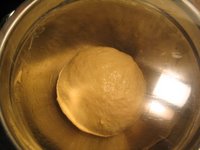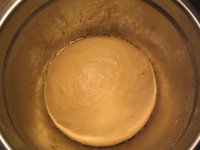
I am going to make some bread tomorrow, the question is, which kind shall I make? It is a question I think I have the answer to, however, when I am unsure, I do have a way to get myself thinking about what kind of loaf to make. What is my strategy for getting myself motivated? What do I do to get my baking mind churning? I make a Biga. "A Biga?" you say? "Barmy Baker, please do tell us what a biga is."
Biga is Italian for pretty much any sort of pre-fermented dough that will be added to a finished bread dough. Why do we make bigas? While the biga is fermenting at room temperature and retarding in the refrigerator it is forming more flavor which makes for a fuller, more rounded flavor in your end product. They are simple to make, and usually will keep in the fridge for up to three days before the yeast dies out. It's quite handy. If you know you want to make a bread on the weekend, you can quickly mix up a biga on Wednesday or Thursday night, and let it chill in the refrigerator for a bit before you commit to what you are going to bake. How do we make a Biga? Well..let me tell you.

The following is a firm sort of a pre-ferment. This one does make use of commercial instant yeast, while some others use natural yeast that is found all around us (this is for another blog and another time). The other type of biga that I like to work with is the one I make for ciabatta (again, another post, another time) which has a far greater amount of water, meaning much higher hydration and yeilding a much looser dough. And now, on with the Biga!

Biga
should make about 1 pound 2 ounces (18 ounces)
2 1/2 cups unbleached bread flour or 11.25 ounces
1/2 teaspoon instant yeast
3/4 cup plus 2 tablespoons to 1 cup water, at room temperature (I leaned more towards 1 cup, as my dough seemed a bit too stiff for my liking)
_____________________________________________________________
-Mix flour and yeast together in a medium sized bowl.
-Stir in water (you can do this with your hands or a spoon. I prefer my hands)
-Mix until a slightly sticky dough is formed and turn out onto a lightly floured surface (cutting board, whatever works for you). Knead for about 4 to 6 minutes adding flour if necessary. You want a somewhat tacky and somewhat smooth ball of dough when you are finished.

-Spray (with pan spray) or oil (I used olive oil) a bowl that is large enough to allow the dough to double in size. Turn the ball of dough in the oil to lightly coat it.
 Cover the bowl with plastic wrap or a damp towel, and let sit out at room temperature for about 2 hours, or until doubled in size.
Cover the bowl with plastic wrap or a damp towel, and let sit out at room temperature for about 2 hours, or until doubled in size.  Cover tightly with plastic wrap, and let the dough have a nice restful slumber in the refrigerator overnight or up to three days.
Cover tightly with plastic wrap, and let the dough have a nice restful slumber in the refrigerator overnight or up to three days.-You will want to pull the Biga from the refrigerator at least an hour before adding it to a bread dough in order to remove the chill from it and wake up the sleeping yeast.
So, what will it be tomorrow? I'm really leaning towards a Potato Rosemary Bread. I've made Rosemary Bread before..but never combined with potatoes in it. I'll let you know after it's all made :)
Have a great night/morning/afternoon wherever you are!





















5 comments:
I have been itching to try my hand at making bread but have never had a clear picture about how to start.I like the idea of the biga so I might have a try at following your directions because they look very clear and hopefully I won't have a disaster on my hands.
I'm always happy to answer any questions that may come up as you try your hand at making bread :). Good luck to you on your bread adventure!
Thanks for your offer of help, I might need some:):)
Thanks for your offer of help, I might need some:):)
You're most welcome! :D
Post a Comment